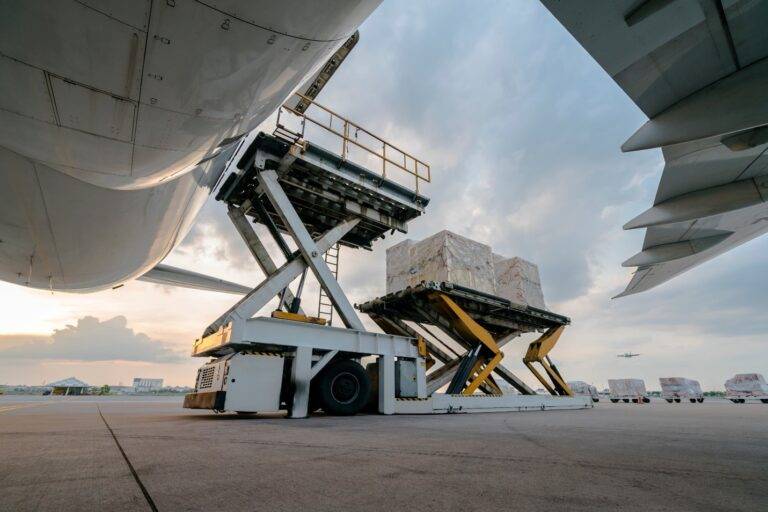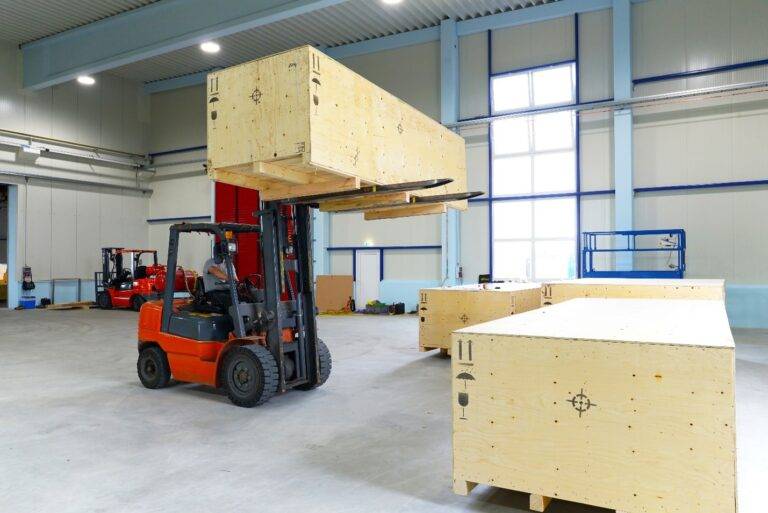When it comes to shipping freight in an expedited manner, there are several strategies to consider.
When faced with a heavy-weight shipment or pallet that needs to be moved quickly, many shippers turn to their overnight or small package carriers for a costly shipping quote. Without a pre-negotiated heavy-weight shipping program, this can be an expensive endeavor.
An often overlooked, reliable, and economical solution for shipping larger freight is to receive a shipment quote from a reputable Domestic Airfreight Forwarder, also referred to as an Indirect Air Carrier (IAC).
A solid Air Freight Forwarder will have pre-negotiated rates with major airlines and cargo carriers, which can provide the following benefits that a small package carrier may not offer. A few major benefits to shipping via Air Freight Forwarder are:
- IAC airfreight forwarders typically have less stringent weight restrictions, so you may be able to avoid costly surcharges.
- Air Freight Forwarders are known for providing a much higher level of flexibility and personalized service than small package carriers.
- Special service requests like inside delivery, two-man delivery, specific site delivery requirements and waiting time are service offerings a freight forwarder can offer.
A solid Air Freight Forwarder will work with you to understand your specific needs and find the best possible solution for your shipment.
Reaching out to a qualified Air Freight Forwarder or Indirect Air Carrier (IAC) for a shipment quote is often a better choice overall.
for a shipment quote is often a better choice overall.
Air Freight and Expedited Trucking

Air freight involves moving cargo from Point to Point via aircraft. Using air freight, cargo is transported quickly across the US, and there are several options for both air freight, ground expedite with guaranteed service time commitments.
Below, we’ve explained the process and inputs for preparing and shipping airfreight within the lower 48, Alaska, Hawaii and Puerto Rico.
First and Foremost: Security and Compliance
You need to think about whether air freight is right for you, understand all that’s involved, have the right documentation, meet specific TSA requirements and engage a professional freight forwarder like Ace West Airfreight to ensure your transaction flows smoothly.
As an Indirect Air Carrier (IAC). TSA requires a qualified Air Freight Forwarder / IAC to participate in approved security programs. The primary system is the Known Shipper Management System, TSA identifies and approves the known shipper status for qualified Airfreight Forwarders to be able to transport their cargo on passenger aircraft. All IACs must comply with a range of specific security requirements to qualify their clients as known shippers.
For shipping domestic air cargo on commercial (non-cargo only) airlines. Shippers must first verify that they are an authorized Known Shipper.
Request A Quote
Once a credit application and a shipper are compliant to shipment by air, the next step is to receive a shipment quote. Air freight is a two-way transaction, so you’ll need to provide shipment details, including description of goods shipped, weight, dimensions, special handling requests, declared value, pickup and delivery date requirements.
Shipment Tip: It’s important to know in advance if the final delivery point will unload the cargo themselves, or if they need a lift gate at pick up or delivery. It’s also useful to know the delivery point’s opening hours to ensure cargo can be delivered within your timeframe.
Documentation:
For international air freight provide commercial documents – yes, unfortunately in shipping international, there is a lot of documentation. Air freight is no exception. An International Air Freight Forwarder can handle all the documentation with to ensure your transaction doesn’t run into any unexpected costs and delays.
For Domestics Shipping here is a list of some the Common Freight Shipping Documents
Bill of Lading (BOL)
A bill of lading, sometimes called the waybill, is the most common freight shipping document. The BOL lists the basic information about your shipment, including the origination and delivery addresses and contact information, the carrier’s information, and a description of the freight.
Freight Bill
The freight bill is similar to the BOL but has more detail such as the shipper’s consolidated cost. It is required along with the BOL so must be filled out completely and accurately. While the BOL is a legally binding document, the freight bill is not.
The BOL also serves as the proof of pickup as it is signed by both the shipper and the carrier at the time of pickup.
Packing List
The packing list provides the full detail of the freight being shipped including a description of the cargo, quantity, SKU or UPC, total weight, and dimensions. The packing list is a very important freight shipping document for multiple reasons:
1 – The packing list, along with the type of freight shipment chosen (FTL, LTL, etc.) determines the cost of the shipment. Accuracy is very important in order to remove potential invoicing surprises post-delivery
2 – The packing list is the official inventory of the items being shipped and validated by the recipient at time of delivery. The packing list is referred to in the event of missing or damaged items for claims submission
3 – In the event a letter of credit (LOC) is being issued by a bank, the packing list may be a required document
4 – For international shipments, the packing list is used during customs clearance to inspect and validate the freight
What happens to your freight once it’s tendered to the airline?

Most major airlines transport freight in the belly of the aircraft or in Air freight containers. Cargo can be shipped in a unit load device (ULD), as a palletized shipment or as loose cargo when shipping via air freight. There are a range of restrictions based on the height, length and width of your cargo. To ensure proper booking can be made with an airline, it is always important to present proper weight and dimensions.
Airlines refer to containers that go into their aircraft as Unit Loading Devices (ULD’s)
Types of ULD’s used for shipping are as follows:
Air freight container LD-8
Air-freight-container-LD-3
Air freight container LD-4
Examples of air freight containers – unit load device (ULD)

In the US Airfreight security regulations require cargo to be examined prior to export (which is mandatory). As required by section 1602 of the “Implementing Recommendations of the 9/11 Commission Act of 2007” (9/11 Act), TSA requires 100% of cargo transported on passenger aircraft to be screened at a level of security commensurate with the level of security for the screening of passenger checked baggage. each individual box, carton or other item; Consolidated form –Including: homogeneous cargo packed on pallets, boxes stacked and wrapped in plastic or in unit load devices (ULDs)
TSA requires each IAC to adopt and carry out a TSA-approved security program that meets current TSA requirements and is renewed annually. See 49 CFR part 1548. TSA Principal Security Inspectors are the primary point of contact for the application process and approval of certification.
Packing your Cargo for Air Shipping

When shipping on commercial and cargo airlines, you will not just pay for the actual weight of your shipment, for example if your cargo is of sizeable dimensions and of lighter weight, dimensional weight factors may be required to determine the weight at which the shipment will be charged.
Here is an example of how dimensional or DIM weight is calculated
Your box measures 60″ x 18″ x 18″ and the parcel weighs 50 lbs. To find the cubic size, you’ll need to multiply 60 x 18 x 18. That yields 19,440 cubic inches. Divided by and industry dimensional factor of /166 = 117 of chargeable pounds
*Note dimensional factors can vary from carrier to carrier and airline to airline. For example, UPS utilizes the highest DIM factor of 139 which creates a higher weight factor than most commercial air carriers.
Your forwarder should provide restrictions applicable to the aircraft. Your cargo will obviously need to fit in the aircraft before it can be shipped. Your forwarder will provide applicable restrictions before shipment booking. The route is correct for you and offers you the best price versus transit time.
When it comes to shipping freight in an expedited manner, there are several strategies to consider.
When faced with a heavy-weight shipment or pallet that needs to be moved quickly, many shippers turn to their overnight or small package carriers for a costly shipping quote. Without a pre-negotiated heavy-weight shipping program, this can be an expensive endeavor.
An often overlooked, reliable, and economical solution for shipping larger freight is to is to receive a shipment quote from a reputable Domestic Airfreight Forwarder, also referred to as an Indirect Air Carrier (IAC).
A solid Air Freight Forwarder will have pre-negotiated rates with major airlines and cargo carriers, which can provide the following benefits that a small package carrier may not offer. A few major benefits to shipping via Air Freight Forwarder are:
- IAC airfreight forwarders typically have less stringent weight restrictions, so you may be able to avoid costly surcharges.
- Air Freight Forwarders are known for providing a much higher level of flexibility and personalized service than small package carriers.
- Special service requests like inside delivery, two-man delivery, specific site delivery requirements and waiting time are service offerings a freight forwarder can offer.
A solid Air Freight Forwarder will work with you to understand your specific needs and find the best possible solution for your shipment.
Reaching out to a qualified Air Freight Forwarder or Indirect Air Carrier (IAC) for a shipment quote is often a better choice overall.

